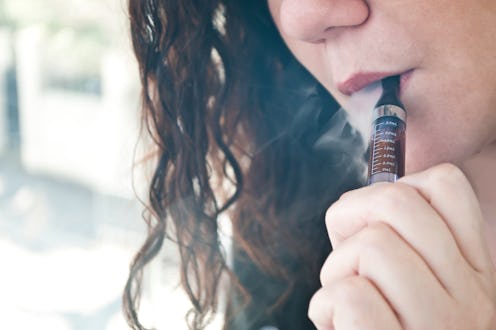
E-cigarette usage is on the rise in high school students, according to a 2018 study by the Centers for Disease Control and Prevention (CDC). That study found that over 3 million students used e-cigarettes — otherwise known as vaping — in 2018, compared to 220,000 students in 2011. Now, eight teenagers have been hospitalized with “severe lung damage” at the Children’s Hospital of Wisconsin, and the common denominator in these hospitalizations is thought to be the young people’s use of e-cigarettes.
Jonathan Meiman, chief medical officer with the Wisconsin Department of Health Services, told the Milwaulkee Journal Sentintel that the hospital is unsure of a single product that the eight teenagers all used that would cause such extensive lung damage. However, he said, “We have a common theme of vaping.” And in a press conference, chief medical officer of the Children’s Hospital of Wisconsin Dr. Michael Gutzeit said that while the young people were experiencing a “variety of illnesses,” the common theme is that “they all have had fairly severe lung damage.”
The teenagers went into the hospital over the course of a month, experiencing extreme coughs and shortness of breath, accompanied by fatigue. Louella Amos, a pediatric pulmonologist at the Children’s Hospital of Wisconsin, told the Milwaukee Journal Sentinel that the teenagers had come to the hospital “not breathing and look[ing] very sick… to the point where they can’t breathe.” Another young person, a 26-year-old man from Burlington, was brought into the hospital in critical condition after he vaped THC from a cartridge that he’d bought on the street, the Sentinel reported.
According to the Johns Hopkins Medicine’s website, the symptoms shown by these teenagers can all be signs of lung damage due to smoking. And doctors and researchers from Johns Hopkins Medicine warn that e-cigarettes can cause significant lung damage and other health complications. And yet, vaping e-cigarettes is on the rise amongst teenagers across the country. Associate professor at the Dartmouth Institute for Health Policy and Clinical Practice, Samir Soneji, leader of a 2019 study published in the journal Public Health Reports, argues that this rise in popularity is directly related to the availability of e-cigarette flavoring. “Stricter regulation or banning of flavored e-cigarettes, such as fruit and candy, can achieve the dual goal of reducing youth vaping,” he said in a Dartmouth news release about his study, “while not burdening older adult cigarette smokers who use e-cigarettes to help quit.”
However, according to the CDC, even e-cigarettes advertised as containing zero nicotine often do contain the addictive substance. And according to a 2014 study published in the journal Tobacco Control, inexperienced users tend to inhale less nicotine per puff than experienced smokers — but, experienced cigarette users can inhale just as much nicotine per puff of an e-cigarette as they can with a traditional cigarette.
In the case of the teenagers admitted to the Children’s Hospital of Wisconsin with lung damage due to e-cigarettes, experience with inhaling maximum nicotine per puff may be irrelevant. This is because regardless of nicotine content in e-cigarettes, flavored vaping liquid itself can cause severe damage to users, resulting in increased potential for heart disease. Because while the variety in vaping flavors seem to be attracting a young clientele to the e-cigarette market, a 2019 study published in the Journal of the American College of Cardiology demonstrated that the e-liquids used in flavored e-cigarettes — regardless of nicotine content — cause significant damage to the body’s endothelial cells, which line the interior of blood vessels and help ensure that blood can flow adequately throughout the body.
The study found that attractive e-liquid flavors like cinnamon, caramel, and vanilla cause damage that is consistent with damage found in the development of heart disease. So while the Wisconsin teenagers are demonstrating signs of immediate lung damage due to e-cigarette use, the long-term health ramifications may also, unfortunately, be severe.